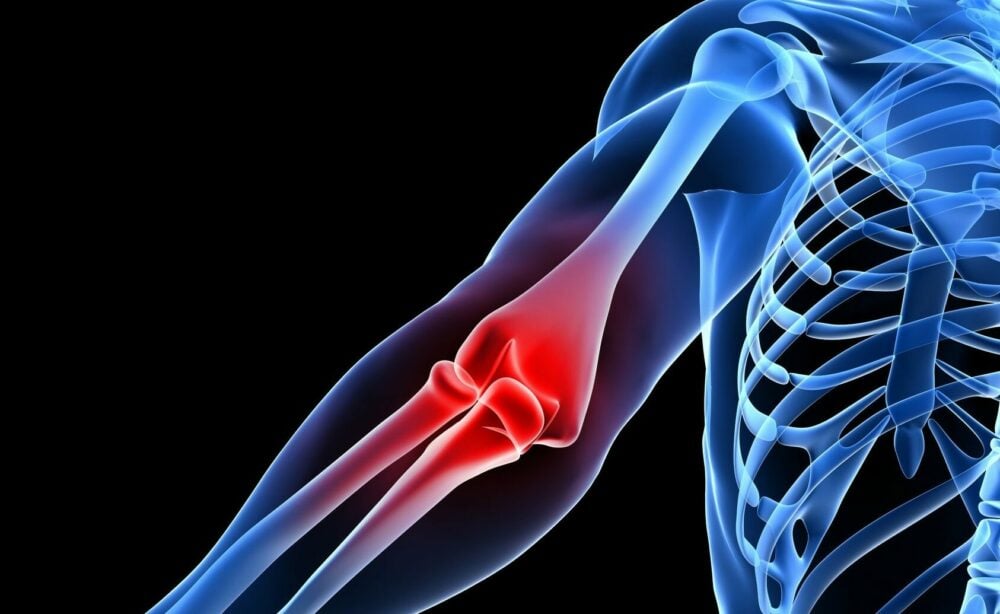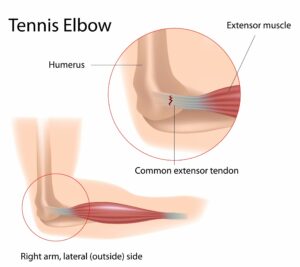Call Us
by Adam Brown
updated July 17, 2020
Your elbow hurts, you’ve been told you have tennis elbow, and yet you haven’t played tennis in years! You need physiotherapy, but first you want to have a good understanding of the problem to make sure you are on the right track.
Tennis elbow, or lateral epicondylitis, is a common condition and is treatable with skilled physiotherapy. However, not all tennis elbows are the same, and they each have to be assessed and treated differently in order to ensure success. Here we will outline some of the common factors that lead to tennis elbow and how to ensure you have an appropriate physiotherapy treatment plan.
What is Tennis Elbow?
Tennis elbow (or lateral epicondylitis) can mean:
- pain on the lateral aspect (outer side) of the elbow
- discomfort when 1) gripping objects 2) when bending your elbow or 3) trying to raise your hand upward against resistance when your palm faces downward.
- damage to the common extensor origin or tendon, which is the area where the tendons from the muscles that extend the wrist and fingers meet.
- usually a very tender point an inch or so past the bony part of the outer elbow (lateral epicondyle).
Tennis elbow can be a persistent problem and patients are often unsure of how to improve their pain. There are two keys to successful physiotherapy treatment of lateral epicondylitis.
ONE: Identify your stage of healing and tailor treatment techniques specific to it.
TWO: Understand all of the factors that contributed to the problem, and create a treatment plan that directly addresses these factors. Treatment should always begin with a detailed physiotherapy assessment that reveals the history of the problem and discovers all of these contributing factors.
Factors That Contribute to Tennis Elbow
As mentioned, every case of tennis elbow is a little different, so no two treatment plans will be exactly the same. A detailed physiotherapy assessment will discover what factors are contributing to your specific problem. Here are some of the more common factors that contribute to this condition and how they can be addressed by your physiotherapist.
1. Repetitive Motions
Tendons are known to break down when the strain that they are required to withstand is more than what their structural integrity can handle or adapt to. This can happen in a single motion where the force is so great that the tendon tears, creating an acute injury OR it can be many small forces over a time-frame that is too fast for the body to safely adapt to. This is why people who have jobs or hobbies that involve repeated movements of the hand, wrist or elbow are at higher risk for developing tennis elbow. When you increase this activity faster than your arm can adapt, tennis elbow will begin. You wouldn’t expect a runner to roll off the sofa and immediately run a marathon. We know that they have to train by slowly increasing mileage, carefully managing the stress on their body so that they can build strength over time and avoid injury.
This principle is not limited to sports. If your job or hobby involves some type of physical strain, increases in this strain must be managed in stages to ensure you’re adapting safely to the new load. Your physiotherapist will help to identify the repetitive motions that are contributing to your problem and can coach you on how much of this activity you should be doing, as well as how to appropriately increase this over time in a way that your body can handle. While healing, it may be necessary to adjust the movement or activity to reduce stress on your tissues.
2. Tightness of Forearm Muscles
The tendons affected by lateral epicondylitis are attached to the muscles of the forearm that extend the wrist and fingers as well as help bend the elbow. For normal and safe arm function, it’s important that these muscles are long and flexible enough to perform all of the tasks required of them. If muscle length is insufficient, the load on these tendons are increased with activities that require wrist, hand and elbow mobility.
It’s important to note that tightness on the other side of the forearm will also have a negative impact (the sider closer to your body, called the flexor side). When you extend your wrist, if you’re working against shortened and stiff wrist flexor muscles, the load on your tendons is similarly increased. These muscles can become tight when they are 1) overused in a shortened position or 2) not used enough in their fully lengthened positions.
People spend most of their work-life doing repetitive administrative tasks and working with computers rather than more varied manual labour involving a variety of arm positions and angles. This opens the door for muscle tightness to develop. Your physiotherapist will look at muscle length and mobility at your elbow, wrist and hand in various positions and combinations to make sure that you have good tissue length to perform all of your required tasks. Stretches and exercises will then be prescribed to regain mobility in tissues that have become shortened.
3. Shoulder Tightness
You might be thinking “what does shoulder stiffness have to do with my elbow pain”. Well the answer is quite simple. When we lack movement at one joint, the neighbouring joints tend to have to make up for it. So, with a simple task that would normally be shared between your wrist, elbow and shoulder, a lack of shoulder mobility will overload the wrist and elbow. Given that tennis elbow is especially vulnerable to increased strain at the wrist and elbow at the same time – you end up with pain. The shoulder may be stiff from hours of poor posture, or from a previous injury. Either way, your physiotherapists should assess your shoulder mobility to see if it is contributing its fair share of mobility to your upper extremity tasks.
4. Neck Problems
Pain, stiffness and dysfunction in the lower neck have been shown to cause ‘tennis elbow like’ elbow pain, even when the neck is not painful. The nerves to the outer elbow exit from the lower cervical spine (or neck joints). As a result, a problem in this lower neck area can refer pain down to the elbow mimicking lateral epicondylitis. This can even cause the classic point tenderness at the elbow and positive physiotherapy muscle tests.
It is important that your physiotherapist examines your neck and takes a detailed history that includes questions about neck pain or stiffness. There are also some very good tests that can help to discover if your neck is involved in producing your elbow pain. If you have a past or current history of neck pain it is important that your physiotherapist considers your neck as a possible source of the problem. If your pain is actually due to an unidentified neck problem, no amount of elbow treatment will provide lasting results!
5. Ergonomics
To ensure successful recovery, it’s important to use strategies and techniques that address the body’s problem directly, and to optimize the environment that the body has to work within. We mentioned briefly that some activities may need to be modified in order for lateral epicondylitis to improve.
Ergonomics is the study of peoples’ physical efficiency in their working environments; how good is the fit between your body and the job you need it to do, in the place you need to do it. It can play an important role in injury prevention and rehabilitation. When it comes to tennis elbow the following factors should be looked at and altered if necessary:
Seating positon – is the keyboard and mouse height ideal to your elbow position? Do the forearms have appropriate support and does the chair promote good sitting posture and alignment?
Grip Size – when tools are used is the size of the grip appropriate for your hand. If the grip is too small or too big you have to use much more force to perform the same task. This is not only true of tools but of sporting equipment like squash or tennis racquets.
Vibration – do any of the tasks that you need to perform expose your arm to vibration? This can be very stressful on the joints and supporting muscles so these tasks must be performed well, with high quality tools and regularly planned breaks from the task.
Treatment for Tennis Elbow
THE RIGHT TREATMENT AT THE RIGHT TIME
You’re now aware of the common factors that cause tennis elbow and how a physiotherapist might address them. Let’s move on to the other important principle of treatment,… timing. A new or ‘acute’ injury needs to be treated very differently than one that is older or ‘chronic’.
Acute injuries show signs of active inflammation; a process that is helping your body to repair. At this time, your therapist needs to reduce physical stress, rest the area and use more gentle techniques that are aimed at ensuring that you get a complete repair. We need to create an environment where your body is allowed to go through the natural healing process that has already begun. And then introduce stresses in a stepwise fashion, when the injury is ready to tolerate increased loads.
Many tennis elbows that come into our clinic are no longer acute but have been a problem for a long period of time. They no longer show the characteristic signs of an inflammatory process, but for some reason they have failed to heal. In these cases, the physiotherapist must use treatment techniques that will kick-start the inflammatory process again in a planned, controlled and responsible manner. Inflammation is the first stage of healing, so physiotherapists are often taking chronic tissue problems and using pro-inflammatory techniques to re-start the healing process over again.
Some techniques that can kick-start healing in a chronic tennis elbow are:
- Manual Therapy
Your Physiotherapist may use hands-on tissue manipulation techniques to create a small amount of micro-trauma to the area to re-sstart the inflammation process.
- Exercises
Specific exercises that have a goal of stressing the tissue to just beyond its current capability can be used as a pro-inflammatory technique.
- Shock Wave Therapy
Extracorporeal Shockwave Therapy (ESWT) can be very effective to help stimulate the inflammatory process. Click here to learn more about shockwave treatment.
These techniques are used at specific intervals of time, to allow the body to go through a natural healing process between treatments.
Final Thoughts
At this point, it’s easy to see that no two tennis elbows are exactly the same. In order to cure your specific tennis elbow, a skilled Physiotherapist must assess what the contributing factors are and understand which stage of healing you are in. Only then are they able to put together a treatment plan that is sure to reach your goal of a pain-free elbow.

Questions? We're happy to help!
Choosing the right service provider can be a big decision. We’re dedicated to answering any questions you have to help you make the best choice. Contact us today and ask us anything!
Call us at (416) 238-6749





